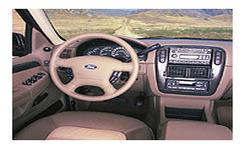In case you’re wondering why the separate frame was retained, Ford answers that this arrangement is more robust for towing (maximum capacity is up from 5800 to 7300 pounds), and it’s better at bearing the suspension loads generated by the company’s rigorous off-road truck duty cycle.
And although the Explorer is not optimized as all Jeeps are for rock hopping across the Rubicon Trail, the approach and departure angles are improved from 28 and 19 degrees to 31 and 24.5 degrees — that’s with or without the trailer hitch, which now nestles up inside the rear bumper. Ground clearance is also up, from 8.5 to 9.2 inches. The Control Trac transfer case is functionally unchanged (switchable among automatic, high, and low modes), but the computer that decides when to engage drive to the front axle in auto mode now reacts much more quickly. This provides better control on slippery surfaces or in deep sand and snow. (Mountaineers continue with a hands-free, viscous-coupled all-wheel-drive system that splits torque 35/65 front to rear.)
Large disc brakes at each corner round out the chassis picture, improving pedal feel and fade resistance dramatically. The ABS logic now changes in four-wheel-drive low mode to allow more wheel slip, which shortens stopping distances at low speeds on loose surfaces by causing dirt to pile up in front of the tires. Our on-road stopping distance of 201 feet from 70 mph was about the same as in our last five-door Explorer.
This can probably best be explained by the 200-pound weight penalty borne by the new truck despite the aluminum suspension bits, fenders, and hood; the magnesium cross-car beam and transfer-case housing; and myriad other weight-loss measures. The new Explorer is simply bigger. Although it’s no longer, it offers four more cubic feet of space in front, nearly two more in the middle seat, and a 40-cubic-foot roomy optional third-row seat (standard at Mercury) that is easier to climb into and more comfortable than the one in a larger Chevy Tahoe. (It also folds flat into the floor.) There’s even a bit more cargo room.
| |
That extra weight stymied our loaded Eddie Bauer four-wheel-drive model in the stoplight grand prix. The base V-6 engine boasts refinement and efficiency improvements along with 10 more pound-feet of torque (to 250), but it makes do with the same 210 horsepower. Sixty mph saunters by in a leisurely 10.7 seconds en route to a 17.9-second quarter-mile run at 77 mph. That’s well off the 9.3- and 17.1-second pace set by a comparable ’97 V-6 model.
To fix this, we highly recommend leaping $695 up the options chart to the SOHC 4.6-liter V-8. Its 240 hp and 280 pound-feet of torque are much better matched to the tasks presented by a loaded Explorer. Acceleration improves to 8.9 seconds from 0 to 60, and to 16.8 seconds at 81 mph in the quarter. That’s about a half-second quicker than our last pushrod V-8 Explorer. (Oh, and — wink, wink — the Cobra’s DOHC 4.6 fits in the new engine bay — hello, SVT?!)
Pulling our heads out from under the dirty parts for a moment, we find the new Explorer to be a much more user-friendly vehicle. The doors are taller, the step-in height is lower, and the seats are properly contoured and made of higher-density, more supportive foam. Interior sealing has been improved to prevent dust intrusion. The pedals adjust, and the steering wheel tilts and telescopes, meaning that everyone from Barney to a Smurf should be able to get comfy.
Curtain side airbags will be optional, offering protection to the front-seat and middle-row-outboard occupants in side impacts and eventually, when a new slower-venting bag phases in, in rollover accidents. A stability-control system will also arrive later in the model year as Ford attempts a quantum leap past the whole Firestone debacle.
Final pricing of the entire range is not yet available, but prices are not expected to inflate anywhere near as much as the added refinement and content would suggest, which should make the entry-level Explorer XLS and XLT extremely competitive. Top-of-the-line Eddie Bauer and Limited models like our $36,915 test car stray into Acura MDX territory where the competition is tougher. The seven-passenger seating option is expected to lure more folks away from minivans, but we caution anyone who expects to fill all those seats for vacation trips to either opt for two-wheel drive or the V-8 to ensure sufficient power for vacation hill-climbs and passing.
As for us? We’re drawn to the sleeker, more-sophisticated-looking Mountaineer — one of the first designs to be penned under Ford styling boss J Mays’s direction. The two trucks are much better differentiated now, and the Mercury is tuned a bit more toward on-road comfort and handling than the Ford.
But regardless of the badging, it doesn’t take a physics degree to appreciate the vast improvement that Ford has wrought here.


Leave a Reply